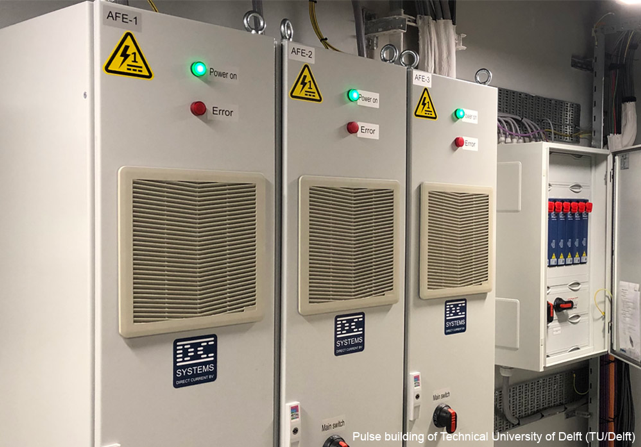PULSE Building – Technical University Delft
DC Systems, as the inventor of the Current OS Protocol is actively supporting design offices and system integrators to make their DC projects possible.
Pulse is the very first building on a university campus that is energy-neutral in the Netherlands. The DC system ensures that the DC generated by solar cells can be used directly, so practically no energy loss, for laptops, tablets, smartphones, lighting and emergency lighting inside the education building. In addition, a DC net saves on materials (eg heavy transformers). Furthermore, it simplifies the transition to the so-called "smart grids", linking generators and users of electricity in the future and keeping the supply and demand of electric power in balance.
The implementation of the DC system was done in collaboration with the installer Kuijpers. The smart DC net at 350VDC in this building consists of:
- USB-C 100W connectors,
- 350V LED lighting Drivers,
- 150kW solar panels,
- Current Routers on Current/OS on 350V LVDC,
- 150kW AC/DC network station based on 3 Active Front End (AFE) connected in parallel.
DC Systems BV supplied the technology and the DC system to connect everything that works on direct current (DC) to a secure 350V DC grid. The DC system and the Current OS safety system is an innovation by Direct Current BV. Almost all devices in the building operate on DC, for example the 490 solar panels (750 m²) on the roof, heat storage in the ground, the LED lighting, USB connection points for computers, mobile phones, and more. By directly connecting all DC products directly to the smart DC grid, a lot of energy and material is saved.

In addition to teaching rooms, the building offers space on the ground floor for catering establishments with approx. 200 seats for relaxation and self-study. An intelligent building management system ventilates, illuminates, cools and heats the various rooms in Pulse depending on usage. The façade openings have been designed in such a way that optimum use is made of daylight. This means less need for artificial light and therefore less energy.
Prof.dr.ir. Andy van den Dobbelsteen, Professor of Climate Design & Sustainability at the Faculty of Architecture, was involved in the development to realize this. Together with students and teachers, the design was realized in collaboration with Royal HaskoningDHV (construction & project management), Valstar Simonis (technical installations) and DGMR (building physics, sustainability and fire safety). The combination Hurks (contractor) and Kuijpers (installer) realized the building.